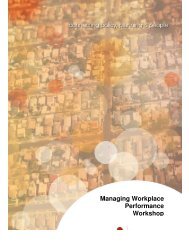Teenage Pregnancy Research Report - 3p Consulting
Teenage Pregnancy Research Report - 3p Consulting
Teenage Pregnancy Research Report - 3p Consulting
You also want an ePaper? Increase the reach of your titles
YUMPU automatically turns print PDFs into web optimized ePapers that Google loves.
Sex EducationThe primary aim of sex education is to provide childrenwith age-appropriate information about sexual health,contraception and negotiating choices about participatingin sexual relationships. The most effective systemsand methods for teaching children about sex, sexualhealth, contraception and relationships, have been wellresearched and documented. 31 Sex education in thosecountries with low teen birth rates have a coherent sexeducation policy and program that is delivered throughthe school system from the early years, continues throughto completion of a child’s schooling and is supportedby accessible contraceptive services. Crucially thesecountries also have community acceptance that sexualactivity is a normal part of adolescence.Feedback from the young people participating in theresearch about their experiences with sex education hasbeen derived from the focus groups, individual interviewsand survey participants. This feedback highlights twoissues. Firstly, the information and scheduling of sexeducation programs is inconsistent from school to schooland therefore the detail, content and topics covereddepend on each individual teacher’s level of knowledge,skill and experience. Secondly, the majority of sexeducation is concentrated in Years 9 and 10, by which timemany of the young parents reported as already sexuallyactive. In some cases, young parents participating inthe research reported having already disengaged fromschool by year 9 or early year 10.Outcomes of the 14 individual interviews included:• Five had participated in sex education in years 9 and/or 10;• Two in years 7 and/or 8;• One in primary school;• Two had a more comprehensive program extendingfrom primary school to year 10; and• Three had not participated in any sex educationThe 11 forum participants all reported experiencingsome sex education in schools and described it as - alittle and mostly in years 9 and 10. Overwhelmingly,apart from one individual who participated in themore comprehensive program, the feedback wasnot positive. Comments included “boring”, “can’tremember”, “embarrassing” and “I didn’t go”. Commonthemes included the concentration on the biologyand physical component of sex did not provide themwith tools to negotiate about contraception with theirsexual partners.So where do young people learn about sex andrelationships? Participants cited a range of methods foraccessing information related to sexual development.These included the internet and social media, popularmedia such as television, movies and magazines, andfriends and family, particularly their mother. Young mensaid they received most of the information from friendsand the internet while young women cited friends andtheir mothers as primary sources of information. Thesurvey respondents also cited friends as being themost likely source of information regarding sex andcontraception (88.9%).It was a shared view of service providers andyoung parents that, in hindsight, there was a lot ofmisunderstanding and ignorance across a range offactors involved in sexual activity. They included, forinstance, how and why the pill works, that “you can’tfall pregnant if you have intercourse in the shower”and three young women who expressed surprise attheir pregnancy as they were told by their mothersfor various reasons that they would “never” be able tohave children.The survey results highlight a lack of detailedunderstanding and knowledge about sex andcontraception with 37.8% of respondents beingunsure if a girl could get pregnant while menstruatingand 80% of young women respondents believing thatbirth control pills are effective even if they miss takingthem for several days in a row. This misunderstandingis alarming in view of the fact that the average age ofthe young women respondents was over 17 years.The local context41



